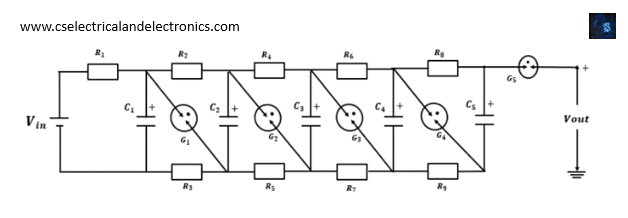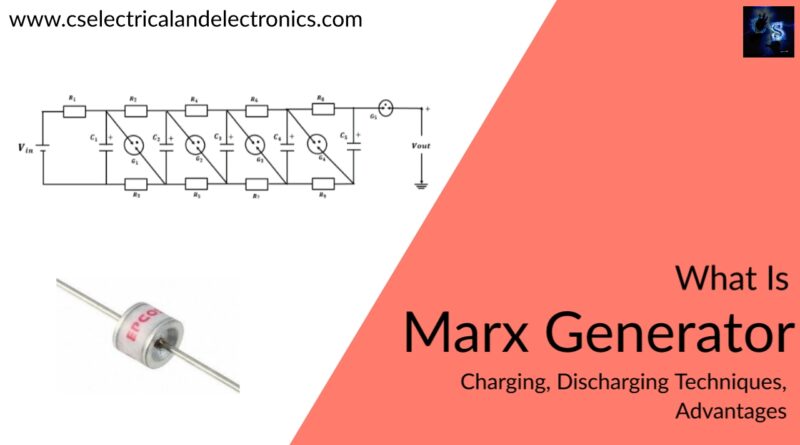What Is Marx Generator, Working, Circuit Design, Applications
Hello guys, welcome back to my blog. In this article, I will discuss what is Marx generator, the working of Marx generator, circuit design, real-time applications, what its use, etc.
If you have any doubts related to electrical, electronics, and computer science, then ask question. You can also catch me @ Instagram – Chetan Shidling.
Also, read:
- How High Voltage Electrical Gloves Work And Are Made Up Of
- Top 15 IoT Projects For Electrical Engineers, Electrical Engineering Project
- What Is Reactor, Types Of Reactors Used In Power Systems, Applications
Marx Generator
In 1924, Erwin Otto Marx developed a multistage impulse-generating circuit. The purpose of this circuit is to generate high impulse voltage from a low voltage power source. The multiplexed impulse generator circuit, often known as the Marx circuit.
The spark gap, which was an open circuit during charging, serves as a switch during discharge and links a series channel through the capacitor bank, generating a very high impulse voltage across the load. To break down the spark gap and activate the Marx generating circuit, the voltage of the first capacitor must be significantly surpassed.
The first spark gap links two capacitors when this happens (C1 and C2). As a result of the two voltages of C1 and C2, the voltage across the first capacitor is doubled. As a result, the third spark gap automatically breaks down since the voltage across it is high enough, and the third capacitor C3 voltage is added to the stack, and so on until the last capacitor.
Finally, when the voltage reaches the last and final spark gap, it is high enough to break the last spark gap over a load with a greater gap between the spark plugs.
Although this is true in perfect circuits, the ultimate output voltage across the last gap will be NVC (where n is the number of capacitors and VC is the capacitor charged voltage). In practice, the Marx Impulse generator circuit’s output voltage will be substantially lower than the desired value.
4-Stage Marx Generator Design
This part explains the components of a 4-stage Marx generator created for charging SC. The Marx generator circuit utilizes GDT (Gas discharge tube) as a sparking unit. The objective is to reach charging SC (Storage capacitor) up to 4 kV for a max of 10 seconds. The Marx generator circuit is shown in the below image is created of a number of resistors and capacitors placed in 4 stages to get higher voltages.
The setup creates the capacitors to be charged in parallel and then discharge in series. The serial discharge causes the output voltage to multiply due to the number of stages. In this article, the output voltage is multiplied 4 times. The serial discharge occurs after the GDT breakdown. The output voltage is defined as,
Vout = n * Vin
When each stage induces a different voltage, the output voltage of the n-stage is defined by,
V’n = Vn + Vn-1

The GDT is an electronic element with gas plasma and is utilized to eliminate transient voltage. As a protective device, the GDT has high insulation resistance, lower capacitance, and lower leakage current to provide minimal effects on typical equipment operations. In easy terms, the structure of the GDT consists of two or more electrodes. Inside GDT, there is a gas-filled gap as an insulator.
When the spark overestimates of the GDT are achieved by voltage disturbance, virtual short will happen. Two-electrodes GDT is symbolized in the above image with names of G1-4 and physically shown in the below image. When DC voltage source (Vin) is provided to the circuit as shown in the above image capacitors will be loaded in parallel. This is named charge mode. Then, at a particular voltage level or when the voltage reaches the breakdown voltage value, the spark gap will work and break through.
It compels the first set capacitor will be connected in series with the second set capacitor. It occurs again for the next step. In this situation, the spark gap has served as a closed switch. Behind the spark occurs, the voltage per stage will be added to the following stage because of the series. After that, the capacitor operates as a voltage source, so that the output voltage (Vout) is equivalent to n x Vc. This is known as release mode. Eventually, the input voltage is multiplied.

Capacitor charging techniques in Marx Generator
There are two ways for charging an SC, i.e. charging by rectifying high AC voltage and charging via another capacitor (flash charging). In demand to charge the SC, both techniques must contain higher voltages than the SC voltage. It is planned that the current can flow from higher voltage to lower voltage. The first way rectifies the high AC voltage is by a step-up transformer to DC voltage.
Yet, this approach has different disadvantages, primarily in the transformer. The Step-up transformer is weighty and has a costly price, vast dimensions, and different electrical losses. The second approach has benefits in charging time. For the identical voltage charging, the capacitor approach is quicker than the transformer one.
Capacitor discharging techniques in Marx Generator
Pulsing an additional trigger electrode: When the Marx generator is completely charged or in a specific scenario, pulsing an additional trigger electrode is an effective approach to intentionally trigger it. Trigatron is the name for the additional trigger electrode. Trigatron comes in a variety of shapes and sizes, each with its own set of specifications.
Ionizing the air in the gap: Ionized air is an efficient method for conducting the spark gap. A pulsed laser is used to ionize the gas.
Reducing the air pressure inside the gap: If the spark gap is constructed inside a chamber, the reduction of air pressure is also effective.
Disadvantages of the Marx Generator
The Marx generator charges the capacitor with resistors, which takes a long time. As a result, the charge time increases. The capacitor closest to the power supply charges more quickly than the others. This is due to the increased distance between the capacitor and the power supply as a result of increased resistance. This is a significant defect in the Marx generator unit.
Loss of efficiency: The Marx generator circuit’s efficiency is reduced as current flows through the resistors for the same reason as previously mentioned.
The electrodes of a spark gap that needs to be replaced from time to time have a short lifespan due to the repetitive discharge cycle via the spark gap.
The charge and discharge cycle repetition time: The impulse generator’s repetition time is quite slow due to the long charge time. This is another significant flaw in the Marx generating circuit.
Applications of Marx Generator
Marx generators are used to generate high-voltage pulses for evaluating the insulation of electrical apparatus such as huge power transformers and insulators that support power transmission lines. For high-voltage apparatus, applied voltages can surpass two million volts.
In the food sector, Marx generators are used to induce cutting improvement or drying acceleration for potatoes and other fruits and vegetables using Pulsed Electric Fields processing.
Conclusion
Marx generator voltage multiplier as an impulse generator created of multi-stage resistors and capacitors to develop a high voltage is offered. In order to cause a high voltage pulse, a number of capacitors are coupled in parallel to charge up during on time and then in series to develop higher voltage during off period.
I hope this article may help you all a lot. Thank you for reading.
Also, read:
- 10 Tips To Maintain Battery For Long Life, Battery Maintainance
- 10 Tips To Save Electricity Bills, Save Money By Saving Electricity
- 100 (AI) Artificial Intelligence Applications In The Automotive Industry
- 100 + Electrical Engineering Projects For Students, Engineers
- 1000+ Control System Quiz, Top MCQ On Control System
- 1000+ Electrical Machines Quiz, Top MCQs On Electrical Machines
- 1000+ Electronics Projects For Engineers, Diploma, MTech Students
- 1000+ MATLAB Simulink Projects For MTech, Engineering Students
Author Profile
- Chetu
- Interest's ~ Engineering | Entrepreneurship | Politics | History | Travelling | Content Writing | Technology | Cooking
Latest entries
 All PostsApril 29, 2024Top 11 Free Courses On Battery For Engineers With Documents
All PostsApril 29, 2024Top 11 Free Courses On Battery For Engineers With Documents All PostsApril 19, 2024What Is Vector CANoe Tool, Why It Is Used In The Automotive Industry
All PostsApril 19, 2024What Is Vector CANoe Tool, Why It Is Used In The Automotive Industry All PostsApril 13, 2024What Is TCM, Transmission Control Module, Working, Purpose,
All PostsApril 13, 2024What Is TCM, Transmission Control Module, Working, Purpose, All PostsApril 12, 2024Top 100 HiL hardware in loop Interview Questions With Answers For Engineers
All PostsApril 12, 2024Top 100 HiL hardware in loop Interview Questions With Answers For Engineers








